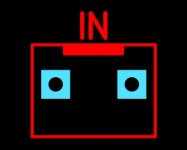Hello Kitty. Catchy name. Hello Kitty amplifier....
Done, done, and done to death.
http://craziestgadgets.com/wp-content/uploads/2010/01/hello-kitty-plush-ipod-dock.jpg
HELLO KITTY lunchbox amplifier | Dendera Bloodbath
https://cdn.instructables.com/FHO/PB0B/HURHNJV9/FHOPB0BHURHNJV9.RECT2100.jpg
https://i.pinimg.com/originals/44/8c/c5/448cc5d4eb0629b82a6c88c61a294db9.jpg
https://www.savingadvice.com/images/blog/hello-kitty-guitar-fender-amp.jpg
https://www.riflegear.com/blogimages/HelloKittyParts.jpg
......Common Mode Choke? Run it balanced. .......
Works fine. Was the core of a very old (Brooks? Bogen?) hi-fi tube amp which pushed the finals into grid current. The driver was two twin-triodes as cathode followers into a 2-coil (CT) choke, to the power tube grids. Only one final grid at a time took grid current, and this coupled all the oomph from four triodes to the one grid sucking.
Disadvantage is you need balanced drive and floating load. Speakers float naturally, and many of you have balanced sources.
In the mofo case, a possible advantage is that the two outputs will be very nearly the same DC level, and you can lose the enormous output cap. (Even if one MOSFET fails, the resulting ~~1V will not smoke any decent woofer.)
Continuing, here is the revised layout that follows UMS guidelines (80 mm x 40mm mounting holes and Mosfet mounting at 15mm away from mounting hole.) Also included cap pitch options for C1.
regards
Prasi
Nice work Prasi. Thank you for yet another great layout and for clarifying what "UMS guidelines" are.

Now...let's get those input terminals spaced at 5mm apart like they should be instead of 2.5mm.
You should know that farther apart LS is better and easier for most DIY folks to solder.
Attachments
Works fine. Was the core of a very old (Brooks? Bogen?) hi-fi tube amp which pushed the finals into grid current. The driver was two twin-triodes as cathode followers into a 2-coil (CT) choke, to the power tube grids. Only one final grid at a time took grid current, and this coupled all the oomph from four triodes to the one grid sucking.
Disadvantage is you need balanced drive and floating load. Speakers float naturally, and many of you have balanced sources.
In the mofo case, a possible advantage is that the two outputs will be very nearly the same DC level, and you can lose the enormous output cap. (Even if one MOSFET fails, the resulting ~~1V will not smoke any decent woofer.)
I am already collecting parts for a F6, so an input transformer should be here soon (Monacor LTR110). This transformer can be used for balancing two MoFo amps.
In my SIM I already took the caps out. Using a second Mosfet for balancing is cheaper than these caps.
The only thing I'm not so certain: can a 5 euro/dollar 68mH/3A common mode toroid really be used in stead of a 25 euro/dollar Hammond. Sounds too good to be true.
OK, well, crazy idea ahead that will demonstrate my ignorance no doubt
What if I use a dual secondary (or primary i suppose) power torroid for the inductor. I wire the secondaries in parallel, except reversing the direction of the coil. Ie the magnetic flux from each secondary is cancelling the other. Thus we get a large value iron core inductor from a power torroid that doesn't saturate with a DC current running through it.
(says the guy with plenty of spare transformers, but no air gap inductors)
I think you are cancelling out the AC part too. So no inductance. Not sure. But if I understand Iron Pumpkin it should be possible to use the powerline for current compensation (the DC voltage going to the amp part).
Hmmmmm......
Hello Kitty. Catchy name. Hello Kitty amplifier....
Hello
For a lunchbox amp it is a bit heavy (~ 70 pounds)
It got its name because it is made entirely of parts that came together over years... Even the IXYS i had bought years ago
wooden frame made in 2003
Cast iron foot from an old machine
Heatsinks from a Sudgen A21a (gift from a friend who found them in the garbage)
Chokes from old projects
Power supplies from dead laptops
It has a number of advantages
difficult for thieves to run away with it
~ 99% recyclable
~ 98% reusable
excellent investment
even sounds decent
What is your impression from the IRLP3034 in that circuit?
Regards,
Johannes
Hello Johannes
Unfortunately i lack the reference point to answer your question, because i use different parts in different topologies.
And in addition both the topologies and the parts have different driving requirements
and my speakers are on the extremes as well (DF requirements)
And i am no good in multifactorial analysis...
In order to make good use of a MoFo i now need a good preamp with
30 x voltage gain, that can swing 12V with low distortion and has a low output impedance
Something around autoformers....
I think you are cancelling out the AC part too. So no inductance. Not sure. But if I understand Iron Pumpkin it should be possible to use the powerline for current compensation (the DC voltage going to the amp part).
I'm going to have to do some more reading I'd say! I was channeling the zen variations 7 article choke loading, and just kinda wondered.
Following that logic though, it'd be easy enough to do a balanced version in the zv7 choke fashion.
I'm going to have to do some more reading I'd say! I was channeling the zen variations 7 article choke loading, and just kinda wondered.
Following that logic though, it'd be easy enough to do a balanced version in the zv7 choke fashion.
Yep. That was my idea too. I always like the Son of Zen concept, but the lack of efficiency scared me out of this. The ZV7-T variant is better, but it needs a huge transformer to operate nice at lower frequencies.
A ZV7-TMF (so Son of a choke loaded MoFo....)
Yep. That was my idea too. I always like the Son of Zen concept, but the lack of efficiency scared me out of this. The ZV7-T variant is better, but it needs a huge transformer to operate nice at lower frequencies.
A ZV7-TMF (so Son of a choke loaded MoFo....)would work with a way smaller choke, because the impedance it sees is way lower.
I bought a few 650VA toroids with 30V secondaries at a knock down price a while back, and had always intended to try a ZV-7T with them. One day. :/ Assuming I finish all the other amps I have lined up.
Last edited:
I bought a few 650VA toroids with 30V secondaries at a knock down price a while back, and had always intended to try a ZV-7T with them. One day. :/ Assuming I finish all the other amps I have lined up.
I would think using the secondaries for a balanced MoFo should work. You don't need a lot of inductance, but a low resistance.
I do have a couple of toroids laying around, but not a lot with twin primaries or secondaries. The cheap surplus types tend to be singles.
The common mode choke option looks tempting. Dirt cheap. Maybe too cheap. The FERYSTER DTS-25/68/2,8-CC-V (68mH @ 2.8A) costs around 3 euro's.
Attachments
A very nice project and very similar to what I have had on the bench for the last few years . I tend to find MOSFETs with lower capacitance sound better , especially if a tube voltage gain stage is used . RD16HHFN1 works well as does the rather more expensive BUZ900P . Semisouth 085 not so good . Currently running BUZ900P with LCLC power supply , Lundahl LL3733 MOSFET choke load and 6E5P plate choke loaded driver stage
Note : if a tube driver is used , always include a gate protection diode
cheers
316a
Note : if a tube driver is used , always include a gate protection diode
cheers
316a
I win something from Pass Lab51department ??

Getting physical prizes out of me starts with having a US shipping address.
Too much trouble filling out customs forms and standing in line at post office.

can such a simple design compete with an Aleph J or F6 for instance? ... Is it naive to think a MoFo can compete with an original Pass design or not?
Not naive at all. Fine design. You should build it.
Transformer in stead of choke
After the reassuring words from Nelson, I'm going to build this one. But I'm still not sure where to start. I see 3 basic options:
But I'm still not sure where to start. I see 3 basic options:
*. MoFo as intended (so with big choke)
*. MoFo balanced with cheap common-mode-choke
*. MoFo balanced with standard toroid as in ZV7-T
This last one intrigues me. I've found an interesting article on John Broskie's site about a balanced mosfet follower using a choke with centre tap (index Simplest MOSFET Amplifiers). Also the use of a input transformer can eliminate the input caps and bias the Fets in F6 style.
But what transformer to use? Of course it should be able to handle the current. In the big MoFo case around 3A per coil. If I understand correctly: the bigger the voltage, the bigger the inductance (more windings). But also more expensive for a given current and bigger resistance.
My guess would be to use the secondaries, not the primaries. But I cannot find a lot of relevant data on normal power transformers (inductance).
Would a 80VA, 2x12VAC toroid do? Does this have 50-150mH?
After the reassuring words from Nelson, I'm going to build this one.
*. MoFo as intended (so with big choke)
*. MoFo balanced with cheap common-mode-choke
*. MoFo balanced with standard toroid as in ZV7-T
This last one intrigues me. I've found an interesting article on John Broskie's site about a balanced mosfet follower using a choke with centre tap (index Simplest MOSFET Amplifiers). Also the use of a input transformer can eliminate the input caps and bias the Fets in F6 style.
But what transformer to use? Of course it should be able to handle the current. In the big MoFo case around 3A per coil. If I understand correctly: the bigger the voltage, the bigger the inductance (more windings). But also more expensive for a given current and bigger resistance.
My guess would be to use the secondaries, not the primaries. But I cannot find a lot of relevant data on normal power transformers (inductance).
Would a 80VA, 2x12VAC toroid do? Does this have 50-150mH?
Wonderful work of Mike Rothacher: very simple and effective.
I want to share a variant inspired by this same project, so as to always keep the simple designs. It is a buffer, whose output can be configured as single ended or push pull. It achieves truly interesting quality parameters.
DLH Amplifier: The trilogy with PLH and JLH amps
regards

I want to share a variant inspired by this same project, so as to always keep the simple designs. It is a buffer, whose output can be configured as single ended or push pull. It achieves truly interesting quality parameters.
DLH Amplifier: The trilogy with PLH and JLH amps
regards
Can i just check, for the measurements in the document, what were the source and load impedances please ? I read it twice but may have missed it in my excitement
8 ohm load. Memory's slipping
 . Gotta check on the generator impedance when I get back to the lab this weekend.
. Gotta check on the generator impedance when I get back to the lab this weekend. - Home
- Amplifiers
- Pass Labs
- Build This MoFo!


